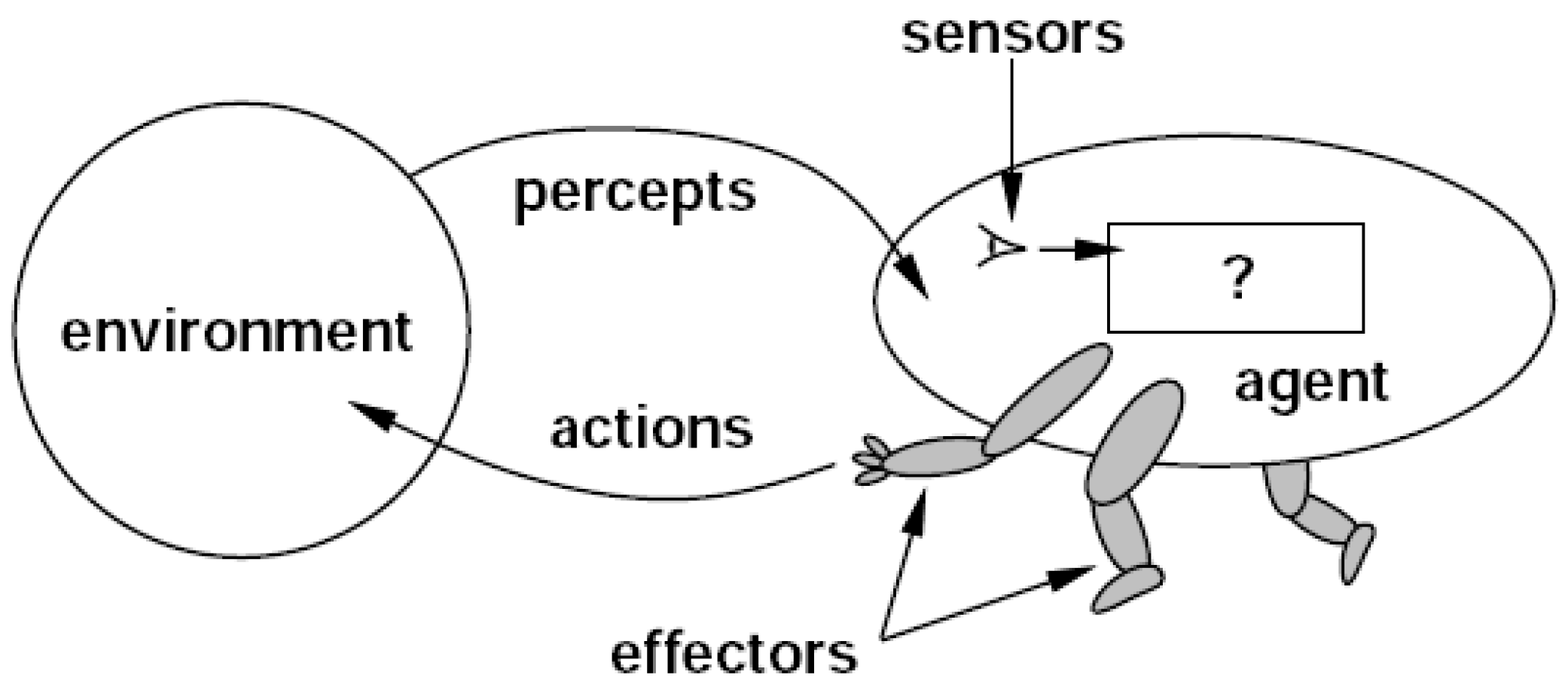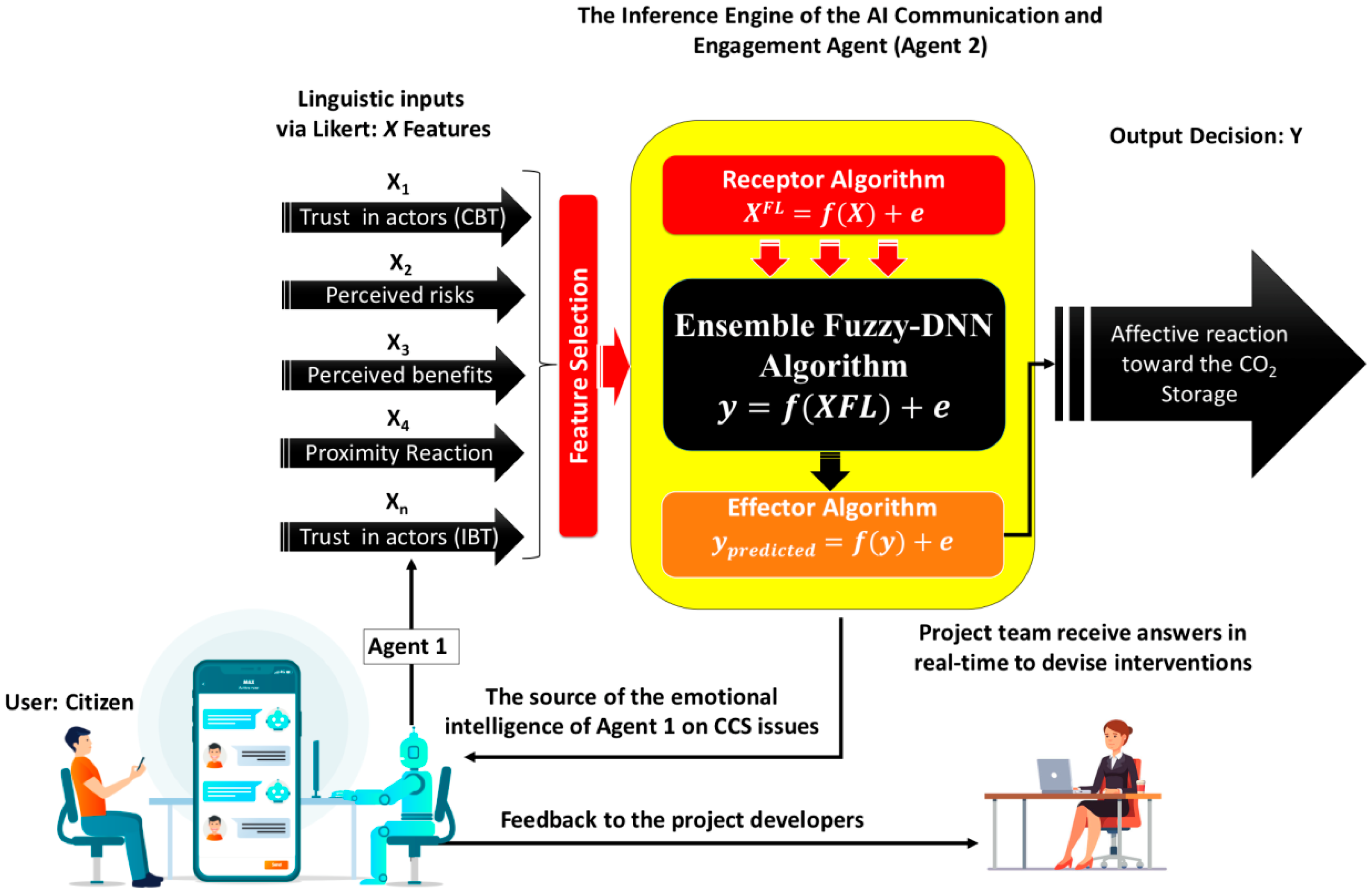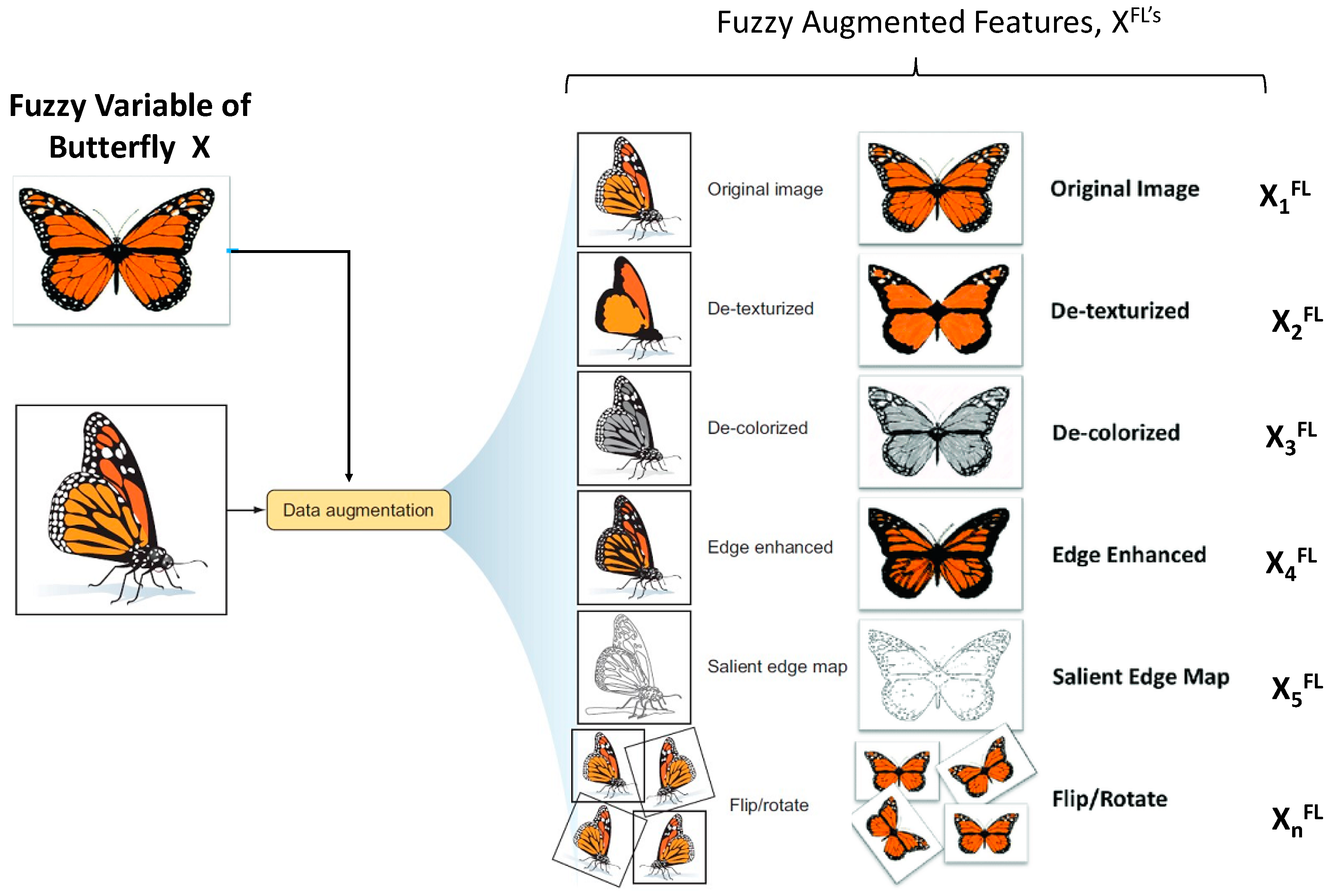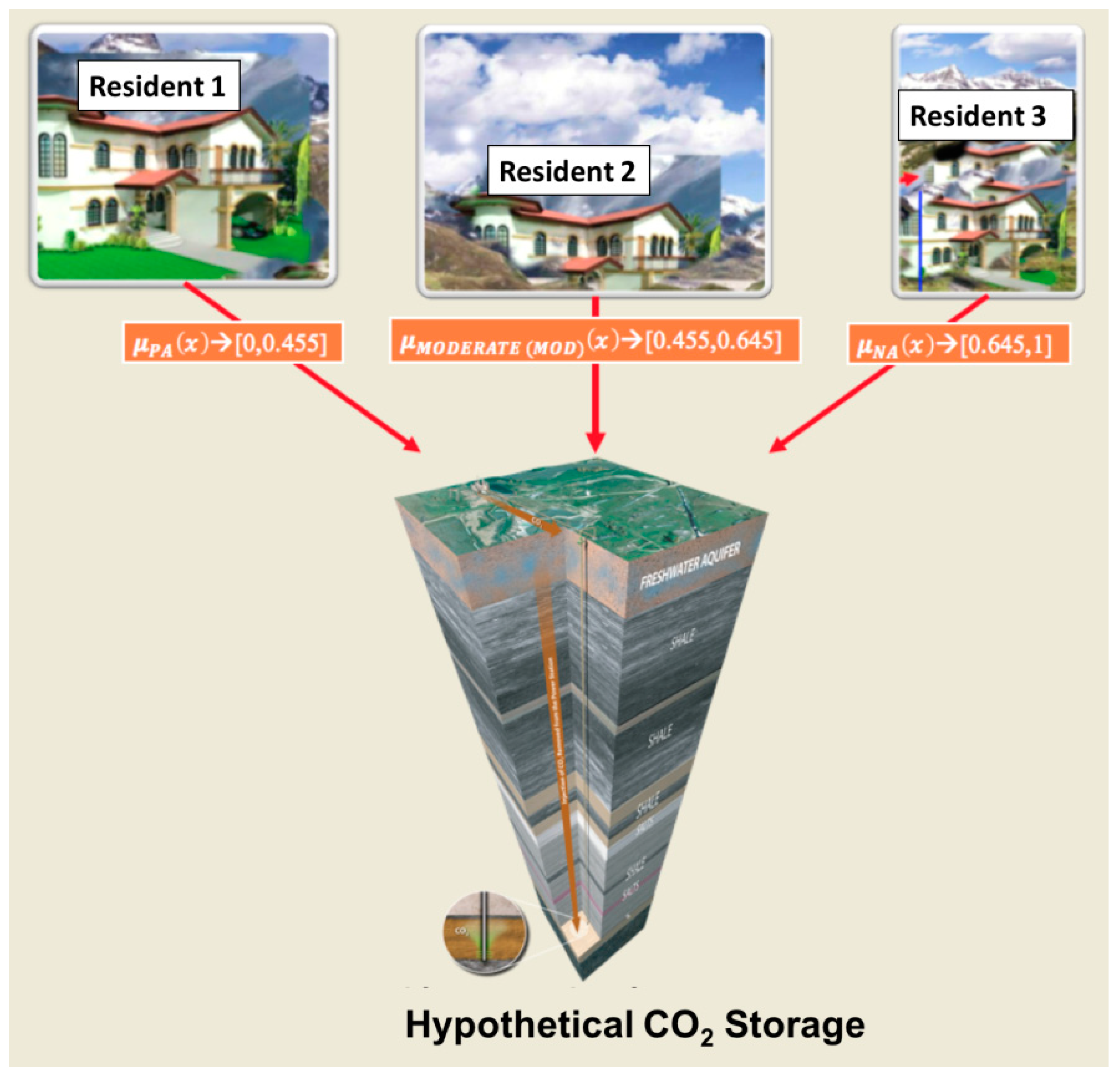Can Artificial Intelligence Assist Project Developers in Long-Term Management of Energy Projects? The Case of CO2 Capture and Storage
Abstract
1. Introduction
2. The Framework of the Proposed AI Communication and Engagement Agent
2.1. General Description of the System
2.2. Basic Mathematics behind the System
2.2.1. The Algorithm’s Output Decision Using Deep Learning
2.2.2. Reaction of the Algorithm
3. Materials and Methods
3.1. Simulation Experiment and Assumption
3.2. Description of the Dataset and Measurements
3.3. Data Pre-Processing and Training
3.4. Agent Validation and Testing
4. Discussion and Implications
5. Conclusions and Limitations of the Work
Author Contributions
Funding
Acknowledgments
Conflicts of Interest
References
- Wüstenhagen, R.; Wolsink, M.; Bürer, M.J. Social acceptance of renewable energy innovation: An introduction to the concept. Energy Policy 2007, 35, 2683–2691. [Google Scholar] [CrossRef]
- Upham, P.; Oltra, C.; Boso, À. Towards a cross-paradigmatic framework of the social acceptance of energy systems. Energy Res. Soc. Sci. 2015, 8, 100–112. [Google Scholar] [CrossRef]
- Dowd, A.M.; James, M. A social licence for carbon dioxide storage and capture: How engineers and managers describe community relations. Soc. Epistemol. 2014, 28, 364–384. [Google Scholar] [CrossRef]
- Gough, C.; Cunningham, R.; Mander, S. Understanding key elements in establishing a social license for CCS: An empirical approach. Int. J. Greenh. Gas Control 2018, 68, 16–25. [Google Scholar] [CrossRef]
- Umar, A.T.; Othman, M.S.H. Causes and Consequences of Crude Oil Pipeline Vandalism in the Niger Delta Region of Nigeria: A Confirmatory Factor Analysis Approach; Cogent Economics & Finance: London, UK, 2017; Volume 5, pp. 1–15. [Google Scholar] [CrossRef]
- Ashworth, P.; Bradbury, J.; Feenstra, C.F.J.; Greenberg, S.; Hund, G.; Mikunda, T.; Shaw, H. Communication/ Engagement Toolkit for CCS Projects, Communication/Engagement Tool Kit for CCS Projects; Energy Transformed Flagship, National Flagships Research, Commonwealth Scientific and Industrial Research Organisation (CSIRO): Canberra, Australia, 2011. [Google Scholar]
- Roeser, S.; Philos, T. Nuclear Energy, Risk, and Emotions. Philos. Technol. 2011, 24, 197–201. [Google Scholar] [CrossRef]
- Janhunen, S.; Hujala, M.; Pätäri, S. The acceptability of wind farms: The impact of public participation. J. Environ. Policy Plan. 2018, 20, 214–235. [Google Scholar] [CrossRef]
- Perlaviciute, G.; Steg, L.; Contzen, N.; Roeser, S.; Huijts, N.M.A. Emotional Responses to Energy Projects: Insights for Responsible Decision Making in a Sustainable Energy Transition. Sustainability 2018, 10, 2526. [Google Scholar] [CrossRef]
- Coyle, F. ‘Best practice’ community dialogue: The promise of a small-scale deliberative engagement around the siting of a carbon dioxide capture and storage (CCS) facility. Int. J. Greenh. Gas Control 2016, 45, 233–244. [Google Scholar] [CrossRef]
- Buah, E.; Linnanen, L.; Wu, H. Emotional responses to energy projects: A new method for modeling and prediction beyond self-reported emotion measure. Energy 2020, 190, 116210. [Google Scholar] [CrossRef]
- LeCun, Y.; Bengio, Y.; Hinton, G. Deep learning. Nature 2015, 521, 436–444. [Google Scholar] [CrossRef]
- Goodfellow, I. Deep Learning; MIT Press: Cambridge, MA, USA, 2018; Available online: www.deeplearningbook.org (accessed on 9 August 2020).
- Breiman, L. Statistical modeling: The two cultures. Statist. Sci. 2001, 16, 199–231. [Google Scholar] [CrossRef]
- Yarkoni, T.; Westfall, J. Choosing prediction over explanation in psychology: Lessons from machine learning. Perspect. Psychol. Sci. 2017, 12, 1100–1122. [Google Scholar] [CrossRef] [PubMed]
- Haszeldine, R.S.; Flude, S.; Johnson, G.; Scott, V. Negative emissions technologies and carbon capture and storage to achieve the Paris Agreement commitments. Philos. Trans. R. Soc. A 2018, 376, 20160447. [Google Scholar] [CrossRef] [PubMed]
- Huijts, N. Sustainable Energy Technology Acceptance: A Psychological Perspective. Ph.D. Thesis, Delft University of Technology, Delft, The Netherlands, 2013. [Google Scholar] [CrossRef]
- Terwel, B.W.; Harinck, F.; Ellemers, N.; Daamen, D.D.L.; De Best-Waldhober, M. Trust as predictor of public acceptance of CCS, In Energy Procedia, Proceedings of the 9th International Conference on Greenhouse Gas Control Technologies (GHGT-9), Washington, DC, USA, 16–20 November 2008; Elsevier Ltd.: Amsterdam, The Netherlands, 2008; Volume 1, pp. 4613–4616. [Google Scholar]
- Wolpert, D.H. Stacked Generalization. Neural Netw. 1992, 5, 241–259. [Google Scholar] [CrossRef]
- Naimi, A.I.; Balzer, L.B. Stacked generalization: An introduction to super learning. Eur. J. Epidemiol. 2018, 33, 459–464. [Google Scholar] [CrossRef]
- Symeona, I.; Kazani, A.Μ. Developing a fuzzy Likert scale for measuring Xenophobia in Greece. ASMDA Rome 2011, 7–10. [Google Scholar] [CrossRef]
- Li, Q. A novel Likert scale based on fuzzy sets theory. Expert Syst. Appl. 2013, 40, 1609–1618. [Google Scholar] [CrossRef]
- Zadeh, L. Fuzzy sets. Inf. Control 1965, 8, 338–353. [Google Scholar] [CrossRef]
- Zadeh, L. The concept of a linguistic variable and its application to approximate reasoning—I. Inf. Sci. 1975, 8, 199–249. [Google Scholar] [CrossRef]
- Deng, L.; Yu, D. Deep Learning: Methods and Applications. Found. Trends Signal Proc. 2014, 7, 197–387. [Google Scholar] [CrossRef]
- Deng, Y.; Bao, F.; Kong, Y.; Ren, Z.; Dai, Q. Deep direct reinforcement learning for financial signal representation and trading. IEEE Trans. Neural Netw. Learn. Syst. 2017, 28, 653–664. [Google Scholar] [CrossRef] [PubMed]
- Huijts, N.M.A.; Midden, C.J.H.; Meijnders, A.L. Social acceptance of carbon dioxide storage. Energy Policy 2007, 35, 2780–2789. [Google Scholar] [CrossRef]
- Midden, C.J.H.; Huijts, N.M.A. The Role of Trust in the Affective Evaluation of Novel Risks: The Case of CO2 Storage. Risk Anal. 2009, 29, 743–751. [Google Scholar] [CrossRef] [PubMed]
- Xuan, Y.; Wang, Z. Carbon capture and storage perceptions and acceptance: A survey of Chinese university students. Int. Proc. Comput. Sci. Inf. Technol. 2012, 38, 1489–1499. [Google Scholar]
- Huijts, N.M.A.; Molin, E.J.E.; Steg, L. Psychological factors influencing sustainable energy technology acceptance: A review-based comprehensive framework. Renew. Sustain. Energy Rev. 2012, 16, 525–531. [Google Scholar] [CrossRef]
- Krause, R.M.; Carley, S.; Warren, D.C.; Rupp, J.; Graham, J.D. “Not in (or Under) My Backyard”: Geographic Proximity and Public Acceptance of Carbon Capture and Storage Facilities. Risk Anal. 2014, 34, 529–540. [Google Scholar] [CrossRef]
- Seigo, S.L.; Dohle, S.; Siegrist, M. Public perception of carbon capture and storage (CCS): A review. Renew. Sustain. Energy Rev. 2014, 38, 848–863. [Google Scholar] [CrossRef]
- Posner, J.; Russell, J.A.; Petersona, B.S. The circumplex model of affect: An integrative approach to affective neuroscience, cognitive development, and psychopathology. Dev. Psychopathol. 2005, 17, 715–734. [Google Scholar] [CrossRef]
- Shmueli, G. To explain or to predict. Stat. Sci. 2010, 25, 289–310. [Google Scholar] [CrossRef]
- Latkin, C.A.; Edwards, C.; Davey-Rothwell, M.A.; Tobin, K.E. The relationship between social desirability bias and self-reports of health, substance use, and social network factors among urban substance users in Baltimore, Maryland. Addict. Behav. 2017, 73, 133–136. [Google Scholar] [CrossRef]
- Gallois, C.; Ashworth, P.; Leach, J.; Moffat, K. The Language of Science and Social Licence to Operate. J. Lang. Soc. Psychol. 2016, 36, 45–60. [Google Scholar] [CrossRef]
- Barrett, L.F. How Emotions are Made: The Secret Life the Brain; Houghton-Mifflin-Harcourt: New York, NY, USA, 2017. [Google Scholar]
- Wilson, T.D.; Gilbert, D.T. Affective forecasting. In Advances in Experimental Social Psychology; Zanna, M.P., Ed.; Academic Press: Cambridge, MA, USA, 2003; Volume 35, pp. 345–411. [Google Scholar]






| Prediction | Associated Statements (Intended Action of the Agent) | Numerical Fuzzy Class Label |
|---|---|---|
| PA (positive affective feelings) | “Oh, my intelligence tells me you don’t have a problem having the CO2 storage close to your house. Did I get your feelings right, and why this decision?” | 0 to 0.455 |
| NA (negative affective feelings) | “Oh, my intelligence tells me you seem to have a problem having the CO2 storage close to your house and want it far away. Did I get your feelings right, and why this decision?” | 0.645 to 1 |
| MOD (moderate feelings) | “Oh, my intelligence tells me you seem to have a problem having the CO2 storage close to your house and want it far away. Did I get your feelings right and why this decision?” | 0.455 to 0.645 |
| IV | Input Variables | IV | Input Variables (IP) and Output Variables (OV) |
|---|---|---|---|
| IV1 | Competence-based trust (CBT): government of my country | IV14 | Risk perception: bad effects on trees and plants by sudden leakage of CO2 |
| IV2 | CBT: industry (e.g., utility companies, oil and gas companies) | IV15 | Risk perception: bad effects on human health from leaked CO2 |
| IV3 | CBT: environmental non-governmental organizations (NGOs) | IV16 | Risk perception: pipeline being destroyed by earthquake |
| IV4 | CBT: Environmental Protection Agency (EPA) of my country | IV17 | Risk perception: bad effects on soil from leaked CO2 |
| IV5 | CBT: scientists and engineers in my country | IV18 | Risk perception: acidification of seawater by leaked CO2 |
| IV6 | Integrity-based trust (IBT): government of my country | IV19 | Risk perception: pipeline being destroyed by corrosion |
| IV7 | IBT: industry (e.g., utility companies, oil and gas companies) | IV20 | Risk perception: reservoir containing the CO2 being destroyed by an earthquake |
| IV8 | IBT: environmental non-governmental organizations (NGOs) | IV21 | Benefit perception: myself |
| IV9 | IBT: Environmental Protection Agency (EPA) of my country | IV22 | Benefit perception: my family |
| IV10 | IBT: scientists and engineers in my country | IV23 | Benefit perception: my future children yet unborn |
| IV11 | Trust in actors as a team | IV24 | Benefit perception: the environment |
| IV12 | Overall risk perception towards CCS | IV25 | Reaction to proximity of the CO2 storage |
| IV13 | Risk perception: sudden release of a large amount of stored CO2 | OV26 | Affective response to the CO2 storage nearby (output predictor of which the algorithm built its emotion intelligence from) |
| Rules | IF ... | THEN ... | Fuzzy Scale Range of
on a 5-Level Membership Function, |
|---|---|---|---|
| Rule 1 | LOW | LOW | 0 to 0.134 |
| Rule 2 | SOMEHOW LOW | SOMEHOW LOW | 0.134 to 0.44 |
| Rule 3 | MEDIUM | MEDIUM | 0.44 to 0.644 |
| Rule 4 | SOMEHOW HIGH | SOMEHOW HIGH | 0.644 to 0.9444 |
| Rule 5 | HIGH | HIGH | 0.944 to 1 |
| Decisive Cases (Positive Affective, PA Feelings, and Negative Affective, NA Reactions) | Indecisive Cases (Moderate Feelings, MOD) | ||
|---|---|---|---|
| Number of cases: 76 | Number of cases: 8 | ||
| Correct | Wrong | Correct | Wrong |
| 70 cases | 6 cases | 6 cases | 2 cases |
| Overall performance on the 84 test data | The algorithm made 8 mistakes and predicted 76 correctly, amounting to a 9.523% error with approximately 90.476% predictive accuracy. | ||
Publisher’s Note: MDPI stays neutral with regard to jurisdictional claims in published maps and institutional affiliations. |
© 2020 by the authors. Licensee MDPI, Basel, Switzerland. This article is an open access article distributed under the terms and conditions of the Creative Commons Attribution (CC BY) license (http://creativecommons.org/licenses/by/4.0/).
Share and Cite
Buah, E.; Linnanen, L.; Wu, H.; Kesse, M.A. Can Artificial Intelligence Assist Project Developers in Long-Term Management of Energy Projects? The Case of CO2 Capture and Storage. Energies 2020, 13, 6259. https://doi.org/10.3390/en13236259
Buah E, Linnanen L, Wu H, Kesse MA. Can Artificial Intelligence Assist Project Developers in Long-Term Management of Energy Projects? The Case of CO2 Capture and Storage. Energies. 2020; 13(23):6259. https://doi.org/10.3390/en13236259
Chicago/Turabian StyleBuah, Eric, Lassi Linnanen, Huapeng Wu, and Martin A. Kesse. 2020. "Can Artificial Intelligence Assist Project Developers in Long-Term Management of Energy Projects? The Case of CO2 Capture and Storage" Energies 13, no. 23: 6259. https://doi.org/10.3390/en13236259
APA StyleBuah, E., Linnanen, L., Wu, H., & Kesse, M. A. (2020). Can Artificial Intelligence Assist Project Developers in Long-Term Management of Energy Projects? The Case of CO2 Capture and Storage. Energies, 13(23), 6259. https://doi.org/10.3390/en13236259







